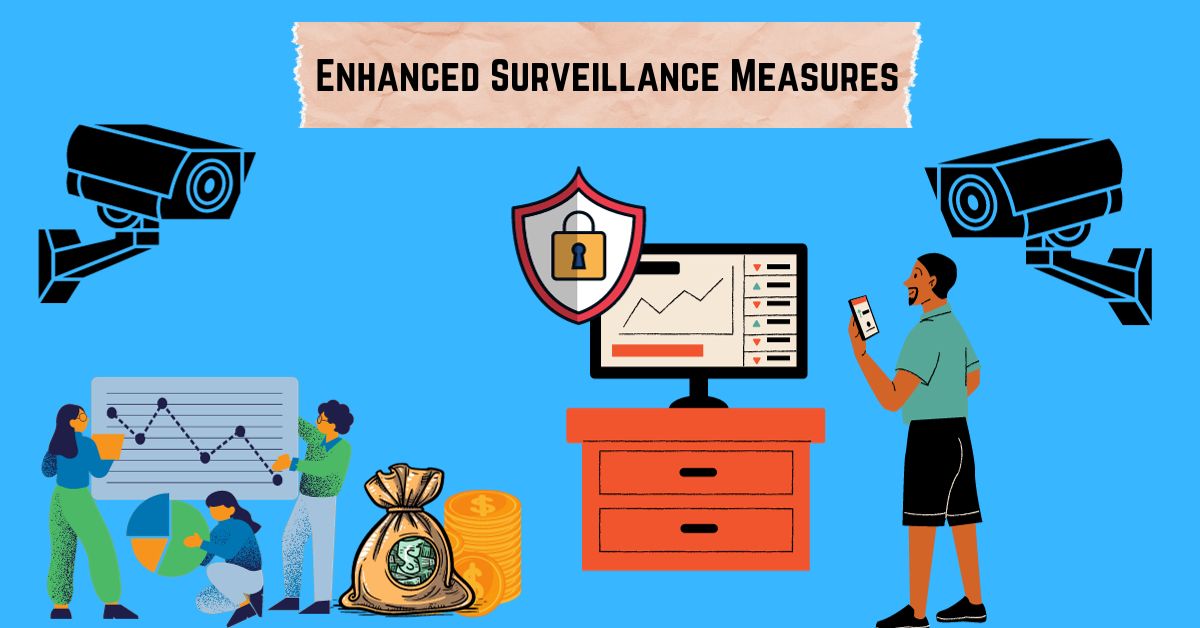Enhanced Surveillance Measures in Stock Exchanges: A Comprehensive Overview
Introduction:
Addressing stock exchanges necessitates the crucial implementation of Enhanced Surveillance Measures to oversee and regulate trading activities. These protective measures ensure the fairness and transparency of trades, simultaneously identifying and thwarting market manipulation, insider trading, and other fraudulent practices. Surveillance measures play a pivotal role in safeguarding market integrity, investor interests, and overall market stability. Detecting and preventing fraudulent activities not only safeguard these aspects but also promote transparent and ethical trading practices.
To enhance market integrity and safeguard investor interests, SEBI (Securities and Exchange Board of India) and stock exchanges continuously introduce diverse surveillance measures. Firstly, they aim to inform and caution investors dealing with such securities. By raising awareness, investors are encouraged to approach these securities with heightened caution, conducting thorough research for informed investment decisions. Secondly, the measures prompt market participants to exercise necessary caution when engaging with these securities. The implementation of surveillance measures contributes to fostering a responsible and knowledgeable trading environment, motivating market players to remain vigilant and proactive in their trading activities.
In addition to existing measures like Additional Surveillance Measures (ASM) and Graded Surveillance Measures (GSM), SEBI and stock exchanges have decided to roll out the Enhanced Surveillance Measure (ESM) framework. This framework is exclusively designed for Micro-Small Companies listed on the main board with a market capitalization of less than ₹500 crores. It came into effect on June 5, 2023, as per NSE Circular no. NSE/SURV/56948 dated June 02, 2023, and BSE Notice No. 20230602-44 dated June 02, 2023.
Shortlisting Criteria for Enhanced Surveillance Measures Framework:
In the Enhanced Surveillance Measure (ESM) framework, specific criteria are employed to select stocks. The shortlisting process comprises two stages:
ESM Stage I:
The shortlisting criteria are met if either of the following conditions is satisfied:
High-Low Price Variation (computed based on corporate action adjusted prices) over a period of 3 months, 6 months, or 12 months equals or exceeds 1 standard deviation of the High-Low variation of all Micro-Small Cap Companies. The minimum thresholds are as follows:
3 months: > 75%
6 months: > 100%
12 months: > 150%
Close-to-Close Price Variation (computed based on corporate action adjusted prices) over a period of 3 months, 6 months, or 12 months equals or exceeds 1 standard deviation of the Close-to-Close Price variation of all Micro-Small Cap Companies as defined above. The minimum thresholds are as follows:
3 months: > 50%
6 months: > 75%
12 months: > 100%
ESM Stage II:
Securities already in Stage I must satisfy the following conditions:
In 5 consecutive trading days: The Close-to-Close Variation is equal to or exceeds 15%.
On a monthly basis: The Close-to-Close Variation is equal to or exceeds 30%.
Nevertheless, there is no cause for concern among Public Sector Enterprises, Public Sector Banks, or Securities offering derivative products, as they are specifically exempted from the ESM framework.
Micro-Small Companies listed on the main board of the stock exchange with a market capitalization of less than ₹ 500 crores.
Impact of Scrips Entering the Enhanced Surveillance Measures Framework:
Securities meeting the Enhanced Surveillance Measure (ESM) criteria may experience changes, including a transfer from the Rolling Settlement segment to the Trade-for-Trade (TFT) segment. The effects differ based on the stage within the Enhanced Surveillance Measures framework:
ESM STAGE I:
For securities in this stage, the applicable margin becomes 100% from T+2 day. Additionally, trade settlement is conducted under a price band of either 5% or 2% if the scrip is already in the 2% band.
ESM STAGE II:
Securities in this stage undergo trade settlement under a 2% price band. Furthermore, trading is permitted once a week with a Periodic Call Auction. Starting July 24, 2023, the applicable margin for these securities becomes 100%, and trade settlement is conducted under a 2% price band on all trading days during Periodic Call Auction, as per NSE Circular no. NSE/SURV/57609 and BSE Notice no. 20230718-46 dated July 18, 2023.
Once a security enters the Enhanced Surveillance Measures framework, it remains there for a minimum of 90 calendar days. However, if a security is in Stage II, it stays in Stage II for a minimum of 1 month. After this month, during the weekly stage review, if the close-to-close price variation is less than 8% within that period, it can move to Stage I of the framework. Securities completing 90 calendar days in the framework (meeting the condition) become eligible for a stage-wise exit, provided they do not meet the entry criteria specified in the Shortlisting criteria for Stage I.
Various Concerns Regarding Entry into ESM Framework:
Entering the Enhanced Surveillance Measure (ESM) framework can pose several challenges for companies, raising substantial concerns:
Trading Restrictions:
Companies in the ESM face restrictions on trading, including trade settlement under stricter conditions and narrower price bands. These limitations can impede trading liquidity, potentially impacting price volatility, and creating challenges for investors.
Negative Market Perception:
Despite exchanges emphasizing that ESM inclusion is solely due to market surveillance, it may still lead to negative perceptions among investors. Being in the ESM could raise concerns about a company’s financial health, governance practices, or compliance issues, affecting investor confidence and the company’s market reputation.
Limited Access to Capital:
Companies in the ESM may find it more difficult to raise funds through capital markets. Negative perceptions, coupled with trading restrictions and heightened regulatory scrutiny, can discourage investors, hindering the company’s ability to attract necessary investments and limiting access to capital for growth and financial stability.
Extended Duration in ESM:
Once a security enters the ESM framework, it remains there for a minimum of 90 calendar days, approximately 60 to 62 trading days. If it moves to Stage II, an additional month, roughly 20 trading days, is added. This extended period lacks mechanisms for expediting the process.
Fairness and Liquidity Concerns:
Questions arise about the fairness of restricting trading and reducing liquidity for companies that have paid listing fees for an entire year. While exchanges argue that these measures are essential for investor protection, the narrowed price band and movement to the TFT segment significantly reduce liquidity for these companies.
Stringency of Measures:
The introduction of stringent measures under ESM raises questions, considering the existence of Additional Surveillance Measure (ASM) and Graded Surveillance Measure (GSM). The impact on liquidity and the necessity of such measures are subjects of scrutiny.
Legal Challenges:
Companies affected by the ESM framework might challenge its validity. For instance, M/s. Mercury EV-Tech Ltd, currently in ESM Stage II, has challenged the framework at the Hon’ble Securities Appellate Tribunal (SAT). This legal challenge reflects the concerns and impacts on trading volumes experienced by companies within the ESM framework.
In summary, the ESM framework brings about potential drawbacks for companies, ranging from trading restrictions and negative market perceptions to challenges in accessing capital and liquidity concerns. These issues warrant a careful evaluation of the framework’s impact on the overall market ecosystem and the companies involved.
Conclusion: Striking a Balance with Enhanced Surveillance Measure (ESM):
In summary, the implementation of the Enhanced Surveillance Measure (ESM) introduces a complex dynamic for companies listed on stock exchanges, encompassing both advantages and disadvantages.
Positive Aspects:
On the positive side, the ESM plays a crucial role in promoting fair and transparent trading practices. Its active detection of market manipulation and protection of investor interests underscores its significance. The heightened regulatory scrutiny accompanying the ESM contributes to market integrity, ensuring a level playing field for all participants.
Potential Drawbacks:
However, the ESM brings forth notable challenges for companies under its purview. Trading restrictions, a key challenge, can impact liquidity due to narrower price bands and stricter trade settlement conditions. These constraints may disrupt trading ease and potentially influence price volatility. Such restrictions can contribute to negative perceptions among investors, raising concerns about the financial health, governance practices, or compliance of the affected companies.
Balancing Act for Regulators and Exchanges:
For regulatory bodies and exchanges, achieving a delicate balance between effective market surveillance and providing growth opportunities for companies is paramount. Striking this balance ensures the maintenance of investor protection without unnecessarily hindering a company’s ability to raise funds, expand operations, and foster sustainable growth.
Proactive Management for Companies:
Companies operating under the Enhanced Surveillance Measures should proactively manage their reputation and engage with investors to address concerns, thereby maintaining trust in the market. The ripple effect of negative perceptions stemming from ESM inclusion emphasizes the need for transparent communication and strategic efforts to regain investor confidence.
In conclusion, the ESM is a tool with a dual nature, serving as a guardian of market integrity while presenting challenges for the companies it encompasses. The ongoing evaluation and fine-tuning of this framework are essential to strike an optimal balance, ensuring the coexistence of robust market surveillance and a conducive environment for corporate growth.










